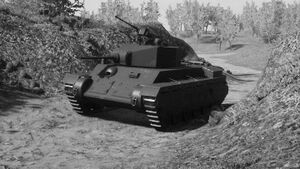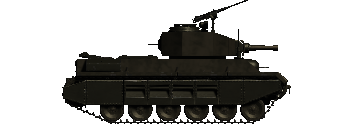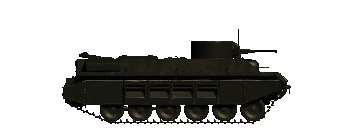RT-8 "Berggeit"
This article is incomplete because it is pending further input from participants, or it is a work-in-progress by one author. Please comment on this article's talk page to share your input, comments and questions. Note: To contribute to this article, you may need to seek help from the author(s) of this page. |
| RT-8 "Berggeit" | |
|---|---|
 An RT-8 "Berggeit" Mk IA undergoing trials. | |
| Type | Light tank |
| Place of origin | Monark van Kooplieden |
| Service history | |
| In service | 1926-TBD |
| Used by | Monark van Kooplieden |
| Wars | Anwnn Civil War |
| Production history | |
| Designer | Verhasselt |
| Designed | 1924 |
| Manufacturer | Verhasselt |
| Produced | 1925-TBD |
| Specifications (RT-8 "Berggeit" Mk IA) | |
| Weight | 12.92 tonnes (12.72 long tons; 14.24 short tons) |
| Length | 4.6 metres (15 ft) |
| Width | 2.0 metres (6.6 ft) |
| Crew | 4 (commander, gunner, driver, radio operator/bow machine gunner) |
| Armour | 30mm (front, angled 50°) 35mm (sides) 20mm (rear) |
Main armament | Royal Ordnance QF 37mm L-20 Anti-Tank Gun |
Secondary armament | 4× 7.92mm machine guns |
| Engine | Bolton Thoroughbred Mk I 20.0L V8 engine |
| Power/weight | 20.4 kilowatts (27.4 hp) / tonne |
| Suspension | Torsion bar |
| Fuel capacity | 400 litres (88 imp gal) |
Operational range | 324 kilometres (201 mi) |
| Speed | 54 km/h, 34 mph (road) 37 km/h, 23 mph (off-road) |
REMINDER: UPDATE EVERYTHING STAT-WISE
The RT-8 "Berggeit" (English: "mountain goat") was a successful light tank design in the Kroonleger's RT-series, and was developed for use in mountainous landscapes and terrain typically inaccessible to tanks. It was lightly armed and armoured, but its manoeuvrability, speed, and climbing performance ensured that it would become the most common tank used by the Kooplieden Monarchy Preservation Corps in the Anwnn Civil War. The unique design choices reminiscent of Kooplieden's earliest tank designs earned it the colloquial title of "the grown-up trench tank".
Development History
Background
When the Kooplieden Monarchy Preservation Corps was raised to participate in the Anwnn Civil War, the Corps's armoured division was lacking in tanks suitable to the mountainous terrain of Anwnn. Most of the division was equipped with the RT-6 "Vechter" Mk I, which was known for its poor performance on hills. The only vehicles in reserve that were specifically built to handle adverse terrain were the original RT-1 "Kever"s and RGC-1 "Neushoorn"s, which were low in numbers and severely outdated by the war's start in 1923. Despite these concerns, all three vehicles saw combat in the first months of the Civil War, but after the Battle of Caelon in which two platoons of RT-1 "Kever"'s were ambushed by rebel forces and captured, they were almost entirely banned from being used in offensive operations until a replacement could be found.
In response, Percy Knowles, in command of the KMPC at the time, drafted a series of requirements for a new light tank to act as a replacement for the RT-1 and RT-6, which became known as the 1923 Mountain Tank Design Specifications No. 1. These requirements called for a tank that had a top speed of at least 50km/h on roads, 30km/h off-road, lighter than 15 tonnes, good turning capabilities, could climb and brake on a 25° slope, resistant to anti-tank rifle fire, and was easily transportable by train. The Kooplieden Army agreed to subsidise production of a successful "mountain tank" design.
Development
Both Stanley Motors, Kooplieden's main tank designer at the time, and Verhasselt expressed interest in the contract and began working on their own designs. Chief Designer Warren Stanley of Stanley Motors came to the conclusion that their conventional design formula – that of a three-plated frontal hull, horizontal volute spring suspension, and frontal sprocket – would be able to climb well if given a powerful engine, but would be slow and heavy. Being the leading expert in tank design within Kooplieden at the time, Knowles listened when Stanley told him about the sacrifices needed to ensure good climbing capabilities, and he removed the speed and weight requirements in the updated 1923 Mountain Tank Design Specifications No. 2. Stanley Motors then began work on their own ill-fated RT-7P.
However, Verhasselt would try to achieve both the speed and weight requirements outlined in the No. 1 specifications. Having developed the chassis for both the RT-1 and RGC-1, and the hull of the RT-1 Mk II, they were experienced in tank design requiring difficult-to-traverse terrain, yet Stanley Motors had been consistently beating them in design contracts, relegating them to a manufacturer of others' designs. Using the design principles of their own RT-1 Mk II, work began on what would eventually become the RT-8P. Work on the engine was outsourced to Bolton.
By early 1924, the RT-8P was ready for testing. Knowles and other Kooplieden Army officers were surprised when the RT-8P met all of the criteria of the No. 1 specifications, and immediately accepted it. Verhasselt began working on a version for mass production, where it was found that the design was also cheap to produce. After being delayed by difficulties in manufacturing torsion bars and the rear-sprocket's transmission, in late 1925 the RT-8 was christened the "Berggeit" and officially began production.
Variants
- RT-8 Mk IA
- The standard version of the RT-8, armed with a 37mm anti-tank gun. The four machine guns consist of a bow machine gun, a coaxial gun, a pintle-mounted machine gun, and a rear facing turret machine gun.
- RT-8 Mk IB
- Same as the Mk IA, but armed with a 75mm howitzer.
- RT-8 Mk IC
- Replaces the main turret for two machine gun turrets, side by side. The gunner operates the right turret, while the commander operates the left one. While weakly armed, with one less machine gun than other versions and no primary armament, the Mk IC was lighter and significantly cheaper.


